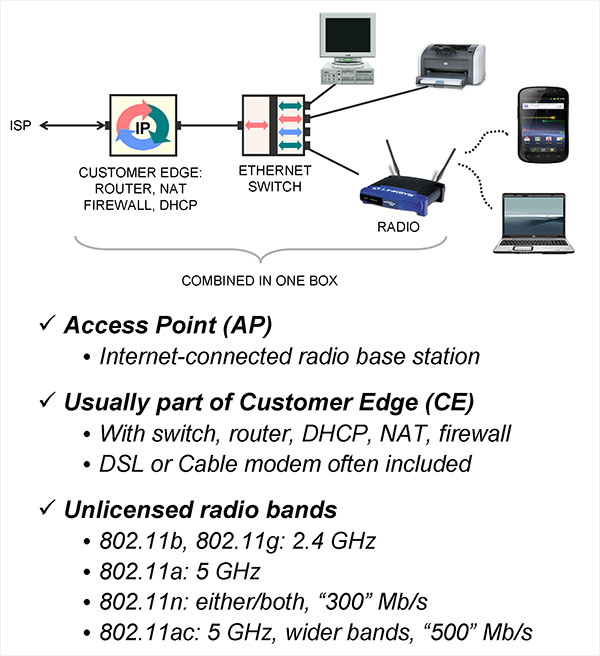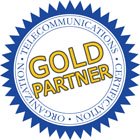Perhaps the most widespread broadband wireless data communication technology today is wireless LAN technology, also referred to as 802.11, Wi-Fi and hotspots. This is essentially Ethernet LANs with space as the physical medium, operating in unlicensed bands at data rates measured in the tens or maybe hundreds of Mb/s and ranges measured in the tens or hundreds of feet.

A typical set-up employs a radio base station, called an Access Point (AP), and wireless interfaces built into devices including computers, printers, cameras, phones and music players.
The Access Point is usually part of a device called the Customer Edge (CE). The CE also includes an Ethernet switch, routing, Dynamic Host Configuration Protocol (DHCP), Network Address Translator (NAT), firewall and port forwarding, and if supplied by an Internet Service Provider (ISP), will also include a DSL or Cable modem, or for the lucky few, a fiber port. Those topics are covered in other courses. This lesson concentrates on the radio aspect of Wi-Fi.
The AP defines a Service Set ID (SSID) text string, which it may or may not broadcast. This shows up on the list of available networks on a wireless device trying to connect.
802.11 wireless LANs are half-duplex: only one device can transmit at a time. Devices transmit only if they have data to send. Otherwise, another device can use the bandwidth. This technique is called statistical Time-Division Duplexing (TDD). It is more efficient than Bluetooth, with its regular TDD reserving half of the slots for each direction whether they will be used or not. But it also means that the actual throughput will be less than half the advertised rate during two-way communications, and worse with each added station using the AP.
Standards are published by the 802.11 working group of the Institute of Electrical and Electronic Engineers (IEEE). These include 802.11a, 802.11b, 802.11g, 802.11n and 802.11ac.
802.11b and g operate in the 2.4 GHz ISM band, offering a maximum of 11 and 54 Mb/s respectively. 802.11b uses Direct Sequence Spread Spectrum like cellular CDMA, and 802.11g implements OFDM like LTE, both allowing multiple devices at the same time in the same space.
However, many other devices including cordless phones, baby monitors and Bluetooth operate in this band, meaning significant performance-lowering interference. It is possible to listen to 802.11b transmissions on an analog 2.4 GHz cordless phone. Microwave ovens operate at 2.4 GHz and can cause radical interference with Wi-Fi communications.
802.11a operates in a 5 GHz unlicensed radio band, supporting a maximum of 54 Mb/s using OFDM. The 5 GHz band is relatively free of interference, but the higher frequency also means shorter range and poorer penetration through walls. In practice, line-of-sight between the access point and the terminal are necessary to achieve 54 Mb/s.
802.11n uses the 2.4 and/or 5 GHz bands, optimizing for power to noise ratio between the bands. 802.11n also supports 20 MHz and/or 40 MHz channels – using more of the wireless spectrum when available to enhance performance, and allows parallel transmission using 1 to 4 radios in Multiple-Input, Multiple-Output (MIMO) systems to achieve very high data rates.
In theory, 802.11n will implement 300 Mb/s with a single antenna… but that would be on the moon, where there are no atoms between the transmitter and receiver and no interference. As soon as there is anything between the transmitter and receiver – like water molecules, plaster, concrete and so forth, and/or interference, the power-to-noise ratio and thus bit rate drops.
802.11ac operates at 5 GHz with wider bands to purportedly achieve 500 Mb/s.
802.11 wireless LANs are mostly used to access the Internet for email, web surfing, youTube, Netflix and the like. Voice over IP (VoIP) telephone calls over Wi-Fi is a growth area.
A cellphone, iPod, or tablet with 802.11 and Skype to connect over the Internet to the telephone network has no need to pay for cellular service to make a phone call whenever the device is in range of an 802.11 network… which may be "most of the time" in the future.









